BSBWRK510 Manage Employ Relations
Added on 2021-02-21
53 Pages10088 Words30 Views
Name: ____________________________


P a g e | 3
1. Assessment criteria for BSBWRK510
2. Manage Employ Relations
In this document, you will find the foundation of what is required to become
competent in this unit. For further information on each element, you can refer to the
Assessment Matrix. Included in this document are the elements for the unit,
foundation skills, assessment requirements as well as an assessment tool definition
list and the crucial observation. As well as all the areas covered here, each student
must also complete all workbook activities, case studies and major activities, where
stated, to become competent within this unit.
NOTE – Re-assessment:
Students will have a maximum of two (2) reassessments attempts if competency
is not achieved in the first instance.
The final grade of ‘C’ for Competent or ‘NC’ for Not Competent is only given at the
completion of the unit of competency when all components or parts of the
assessment are graded as ‘S’ for Satisfactory. Unsatisfactory results are marked as
NS.
Elements for Competency Demonstration
Elements for Competency Assessment:
1. Develop employee and industrial relations policies and plans
2. Implement employee relations policies and plans
3. Manage negotiations to resolve conflict.
Performance Evidence:
Evidence of the ability to:
Analyse organisational documentation to determine long-term
employee relations objectives and current employee relations
performance
Collaborate with others to develop and review industrial relations
policies and plans
Develop implementation and contingency plans for industrial relations
policies
Identify the skills and knowledge needed to implement the plan and
organise training and development for self and staff
1. Assessment criteria for BSBWRK510
2. Manage Employ Relations
In this document, you will find the foundation of what is required to become
competent in this unit. For further information on each element, you can refer to the
Assessment Matrix. Included in this document are the elements for the unit,
foundation skills, assessment requirements as well as an assessment tool definition
list and the crucial observation. As well as all the areas covered here, each student
must also complete all workbook activities, case studies and major activities, where
stated, to become competent within this unit.
NOTE – Re-assessment:
Students will have a maximum of two (2) reassessments attempts if competency
is not achieved in the first instance.
The final grade of ‘C’ for Competent or ‘NC’ for Not Competent is only given at the
completion of the unit of competency when all components or parts of the
assessment are graded as ‘S’ for Satisfactory. Unsatisfactory results are marked as
NS.
Elements for Competency Demonstration
Elements for Competency Assessment:
1. Develop employee and industrial relations policies and plans
2. Implement employee relations policies and plans
3. Manage negotiations to resolve conflict.
Performance Evidence:
Evidence of the ability to:
Analyse organisational documentation to determine long-term
employee relations objectives and current employee relations
performance
Collaborate with others to develop and review industrial relations
policies and plans
Develop implementation and contingency plans for industrial relations
policies
Identify the skills and knowledge needed to implement the plan and
organise training and development for self and staff
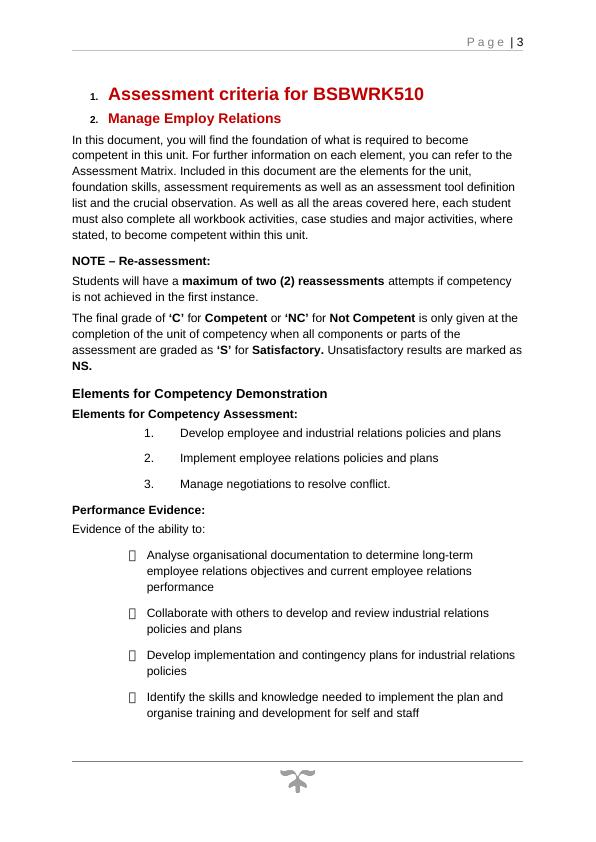
Document and communicate strategies and procedures for eliminating
and dealing with grievances and disputes
Train others in conflict-resolution techniques
Manage industrial relations conflicts, including advocating the
organisation’s position during negotiations and documenting,
implementing and following up agreements.
Note: If a specific volume or frequency is not stated, then evidence must be provided
at least once.
Foundation Skills:
Reading
Interprets, critically analyses and applies appropriate strategies to
construct meaning from complex texts
Writing
Displays knowledge of required structure and layout, employing broad
vocabulary, grammatical structure and conventions appropriate to
purpose and audience
Oral communication
Conveys information using language and non-verbal features
appropriate to the audience
Employs listening and questioning techniques to clarify and confirm
understanding
Numeracy
Extracts and evaluates the mathematical information embedded in a
range of tasks and texts
Navigate the world of work
Modifies or develops organisational policies to achieve organisational
goals and comply with legislative requirements
Keeps up to date on changes to legislation or regulations relevant to
own rights and responsibilities and considers implications of these
Interact with others
and dealing with grievances and disputes
Train others in conflict-resolution techniques
Manage industrial relations conflicts, including advocating the
organisation’s position during negotiations and documenting,
implementing and following up agreements.
Note: If a specific volume or frequency is not stated, then evidence must be provided
at least once.
Foundation Skills:
Reading
Interprets, critically analyses and applies appropriate strategies to
construct meaning from complex texts
Writing
Displays knowledge of required structure and layout, employing broad
vocabulary, grammatical structure and conventions appropriate to
purpose and audience
Oral communication
Conveys information using language and non-verbal features
appropriate to the audience
Employs listening and questioning techniques to clarify and confirm
understanding
Numeracy
Extracts and evaluates the mathematical information embedded in a
range of tasks and texts
Navigate the world of work
Modifies or develops organisational policies to achieve organisational
goals and comply with legislative requirements
Keeps up to date on changes to legislation or regulations relevant to
own rights and responsibilities and considers implications of these
Interact with others
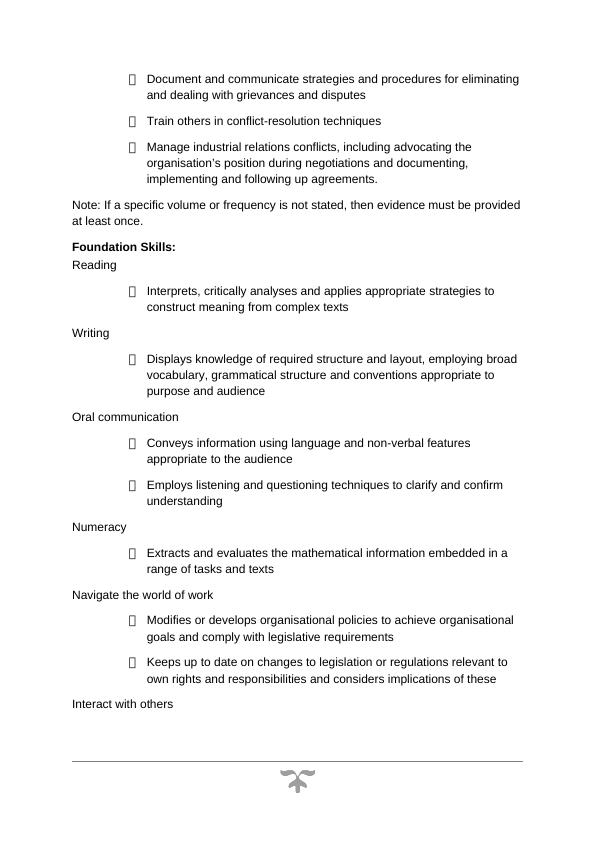
P a g e | 5
Collaborates with others to achieve joint outcomes, playing an active
role in facilitating effective group interaction, influencing direction and
taking a leadership role on occasion
Actively builds networks that include key people with expert skills and
knowledge
Uses a range of strategies to facilitate an acceptable outcome for all
parties where conflicts occur
Get the work done
Sequences and schedules complex activities monitors implementation
and manages relevant communication
Uses analytical techniques to identify issues and generate possible
solutions, seeking input from others as required, before making
decisions or implementing solutions
Draws on the diverse perspectives of others to gain insights into
current practices and opportunities for change
Knowledge Evidence:
To complete the unit requirements safely and effectively, the individual must:
Explain relevant industrial relations legislation or regulations
Summarise enterprise and workplace bargaining processes
Summarise key entities in the current Australian industrial relations
system, including courts and tribunals, trade unions and employer
bodies
Relevant industrial, workplace health and safety, equal
employment opportunity and antidiscrimination legislation in
federal, state and territory jurisdictions.
Assessment Conditions:
Assessment must be conducted in a safe environment where evidence gathered
demonstrates consistent performance of typical activities experienced in the
workforce development – workplace relations field of work and include access to:
Awards and enterprise bargaining agreements
Relevant legislation, regulations, standards and codes
Relevant workplace documentation and resources
Collaborates with others to achieve joint outcomes, playing an active
role in facilitating effective group interaction, influencing direction and
taking a leadership role on occasion
Actively builds networks that include key people with expert skills and
knowledge
Uses a range of strategies to facilitate an acceptable outcome for all
parties where conflicts occur
Get the work done
Sequences and schedules complex activities monitors implementation
and manages relevant communication
Uses analytical techniques to identify issues and generate possible
solutions, seeking input from others as required, before making
decisions or implementing solutions
Draws on the diverse perspectives of others to gain insights into
current practices and opportunities for change
Knowledge Evidence:
To complete the unit requirements safely and effectively, the individual must:
Explain relevant industrial relations legislation or regulations
Summarise enterprise and workplace bargaining processes
Summarise key entities in the current Australian industrial relations
system, including courts and tribunals, trade unions and employer
bodies
Relevant industrial, workplace health and safety, equal
employment opportunity and antidiscrimination legislation in
federal, state and territory jurisdictions.
Assessment Conditions:
Assessment must be conducted in a safe environment where evidence gathered
demonstrates consistent performance of typical activities experienced in the
workforce development – workplace relations field of work and include access to:
Awards and enterprise bargaining agreements
Relevant legislation, regulations, standards and codes
Relevant workplace documentation and resources

Case studies and, where possible, real situations
Interaction with others.
Assessors must satisfy NVR/AQTF assessor requirements.
Links:
Interaction with others.
Assessors must satisfy NVR/AQTF assessor requirements.
Links:
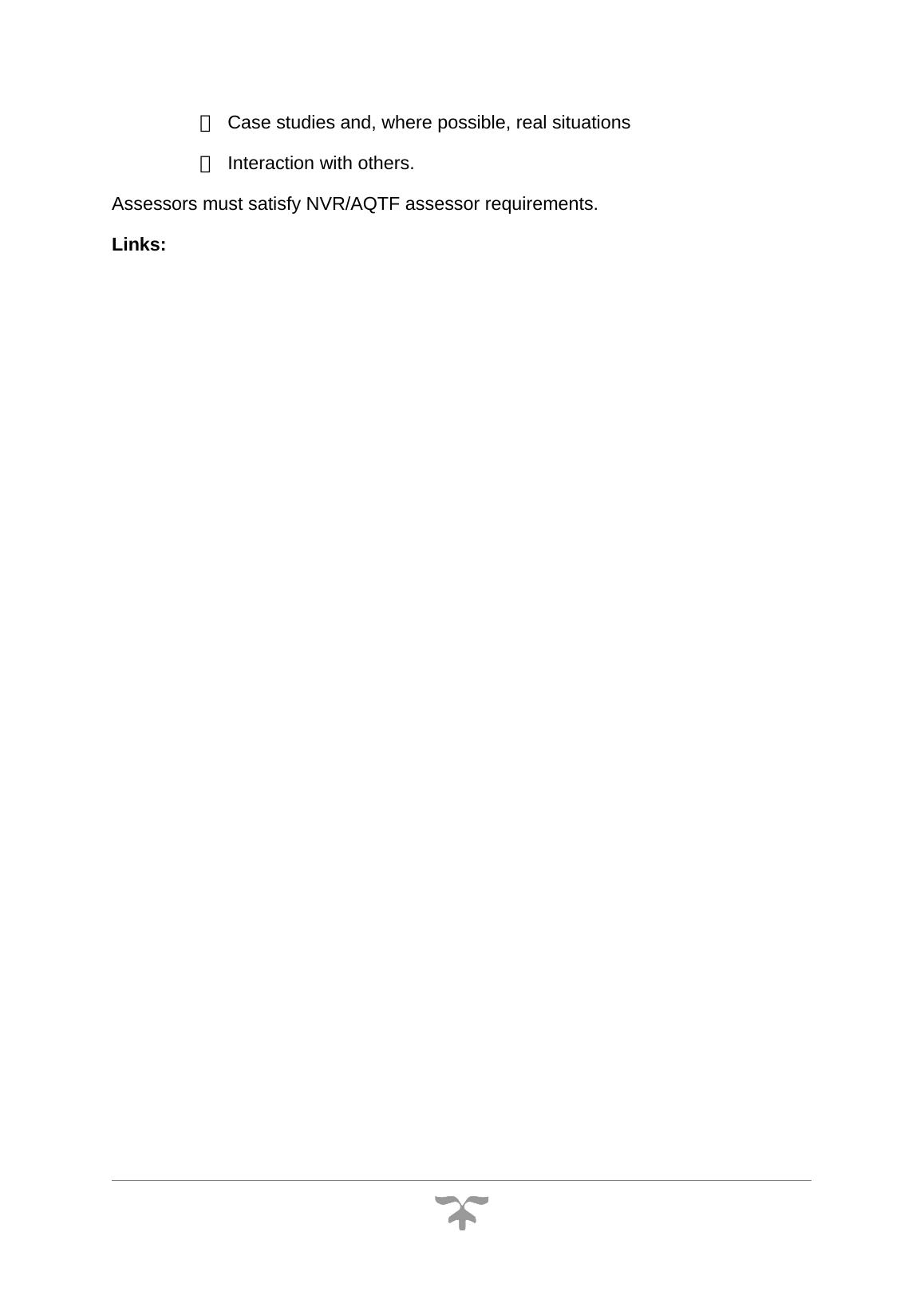
P a g e | 7
Companion volumes available from the IBSA website:
http://www.ibsa.org.au/companion_volumes -
http://www.ibsa.org.au/companion_volumesAny observations and practical
assessments must be recorded in the observation checklist. All practical tasks
should be demonstrated during the length of the course. As the instructor, you must
maintain a record demonstrating the date of the practical activities and any
comments relevant to the performance of each student. Where a student is not able
to demonstrate competence in a practical observation activity, further questioning
should be put in its place.
As the instructor, you could be assessing the student’s literacy, numeracy and
language skills, as well as the content and context of his/her answers.
In some cases, you will have to adjust and amend the assessment tools, using
different and varied methods (such as oral assessment), to allow students to be
assessed according to their needs and abilities.
Companion volumes available from the IBSA website:
http://www.ibsa.org.au/companion_volumes -
http://www.ibsa.org.au/companion_volumesAny observations and practical
assessments must be recorded in the observation checklist. All practical tasks
should be demonstrated during the length of the course. As the instructor, you must
maintain a record demonstrating the date of the practical activities and any
comments relevant to the performance of each student. Where a student is not able
to demonstrate competence in a practical observation activity, further questioning
should be put in its place.
As the instructor, you could be assessing the student’s literacy, numeracy and
language skills, as well as the content and context of his/her answers.
In some cases, you will have to adjust and amend the assessment tools, using
different and varied methods (such as oral assessment), to allow students to be
assessed according to their needs and abilities.
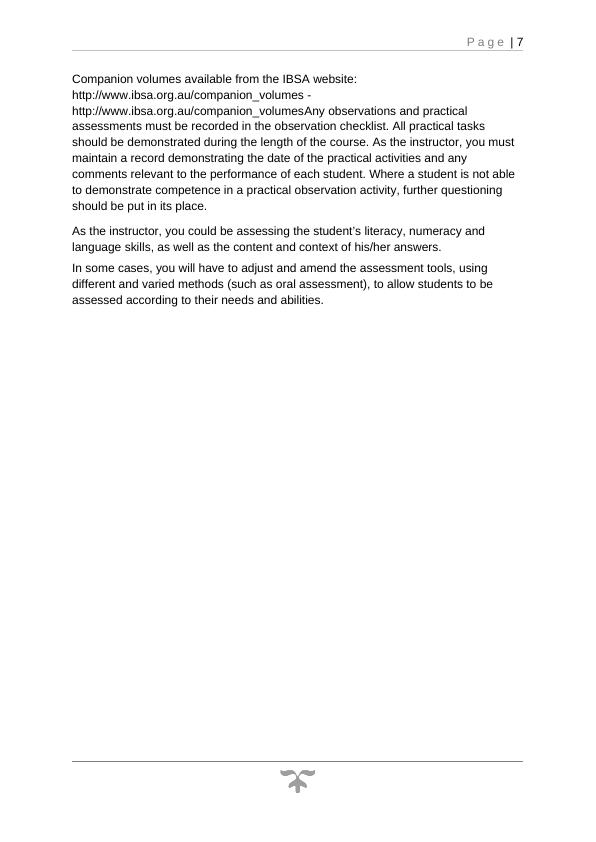
Assessment Tool Definitions
Assessment Tool How is it used? What is it?
Learner Workbook Activities
(Entire completion is required)
Each student should be given a Learner Workbook
which will hold several activities, both formative and
summative, that all need to be completed in
conjunction with the appropriate sessions. The
PowerPoint, Learner Guide and instructor should
provide further information to help with the activities.
Observation/Demonstration
(To be completed for each numbered
point as stated on the checklist)
An observation should be completed for each of the
students by the instructor. If the tasks aren’t
everyday actions, a simulated environment is
acceptable, or a demonstration can be set up. An
observation checklist can be found at the end of this
document.
Major Activity
(Entire completion is required)
A Major Activity is a summative assessment and can
be found in the Learner Workbook, after all the
activities are completed. This is an extended piece of
summative assessment which should take anywhere
between 1-2 hours and every student should
complete this work. It is a requirement for each unit
to check knowledge and understanding.
Skills and Knowledge Activity
(Entire completion is required)
A Skills and Knowledge Activity is a summative
assessment and is found before the Major Activity in
the Learner Workbook. This should take between 1-2
hours and every student should complete this work. It
is a requirement for each unit to check knowledge
and understanding of the foundation skills and
knowledge evidence.
Case Study
(Entire completion is required)
Not all units will have Case Studies but those that do
will be clearly stated within the PowerPoint and the
Learner Workbook. It will appear as any other
activity, but it will be named ‘Case Study’ and will
provide an example of a possible real-life situation for
the learner to read, interpret and then answer
questions on.
Learner Guide
(To be used as an informational guide)
The Learner Guide links with the Learner Workbook
as it provides the information given during sessions
and more. It can help students to further their
knowledge and to also complete the activities.
Evidence Document
(Not a necessity for completion of unit
but can be used as an aid or to collect
further evidence)
The Evidence Document lists all the Elements and
Performance Criteria with an area for written reports
etc, to add evidence to the student’s portfolio. It can
be used for any of the performance criteria,
especially those which may not have been covered
by any other assessment tool. The student can circle
several the criteria that they may feel they need
further evidence of, or it can be used as a guide for
completing further Observations and Third-Party
reports.
Assessment Tool How is it used? What is it?
Learner Workbook Activities
(Entire completion is required)
Each student should be given a Learner Workbook
which will hold several activities, both formative and
summative, that all need to be completed in
conjunction with the appropriate sessions. The
PowerPoint, Learner Guide and instructor should
provide further information to help with the activities.
Observation/Demonstration
(To be completed for each numbered
point as stated on the checklist)
An observation should be completed for each of the
students by the instructor. If the tasks aren’t
everyday actions, a simulated environment is
acceptable, or a demonstration can be set up. An
observation checklist can be found at the end of this
document.
Major Activity
(Entire completion is required)
A Major Activity is a summative assessment and can
be found in the Learner Workbook, after all the
activities are completed. This is an extended piece of
summative assessment which should take anywhere
between 1-2 hours and every student should
complete this work. It is a requirement for each unit
to check knowledge and understanding.
Skills and Knowledge Activity
(Entire completion is required)
A Skills and Knowledge Activity is a summative
assessment and is found before the Major Activity in
the Learner Workbook. This should take between 1-2
hours and every student should complete this work. It
is a requirement for each unit to check knowledge
and understanding of the foundation skills and
knowledge evidence.
Case Study
(Entire completion is required)
Not all units will have Case Studies but those that do
will be clearly stated within the PowerPoint and the
Learner Workbook. It will appear as any other
activity, but it will be named ‘Case Study’ and will
provide an example of a possible real-life situation for
the learner to read, interpret and then answer
questions on.
Learner Guide
(To be used as an informational guide)
The Learner Guide links with the Learner Workbook
as it provides the information given during sessions
and more. It can help students to further their
knowledge and to also complete the activities.
Evidence Document
(Not a necessity for completion of unit
but can be used as an aid or to collect
further evidence)
The Evidence Document lists all the Elements and
Performance Criteria with an area for written reports
etc, to add evidence to the student’s portfolio. It can
be used for any of the performance criteria,
especially those which may not have been covered
by any other assessment tool. The student can circle
several the criteria that they may feel they need
further evidence of, or it can be used as a guide for
completing further Observations and Third-Party
reports.
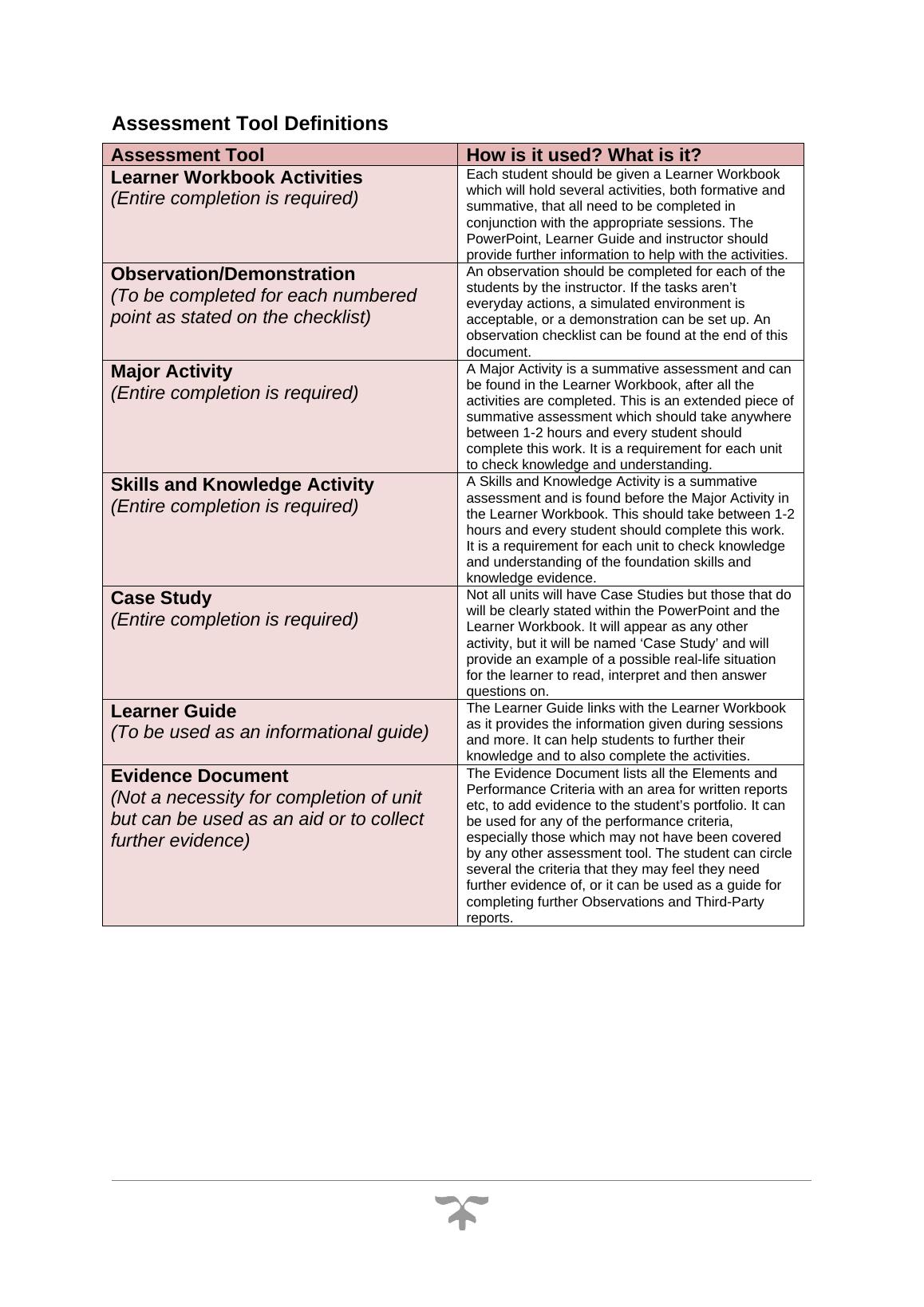
End of preview
Want to access all the pages? Upload your documents or become a member.
Related Documents
Assessment criteria for BSBSUS501 Develop Workplace Policy and Procedures for Sustainabilitylg...
|48
|9105
|85
Assessment Criteria for BSBHRM602 Manage Human Resources Strategic Planninglg...
|57
|10077
|341
Manage Performance Management Assignmentlg...
|48
|10005
|201
Assessment Criteria for BSBHRM512lg...
|21
|4372
|1
Develop and Manage Performance Management Processes Learnerlg...
|58
|13212
|11
BSBMGT403 Implement Continuous Improvement Learner Workbooklg...
|40
|6531
|304
